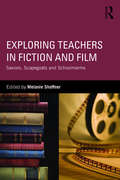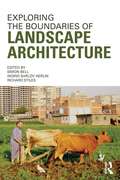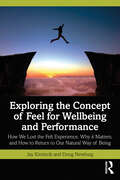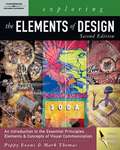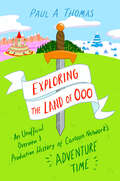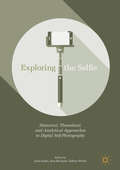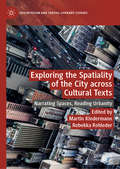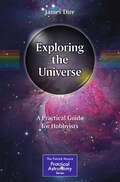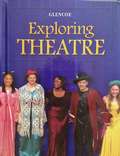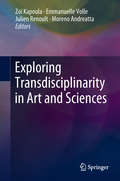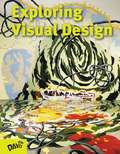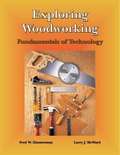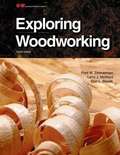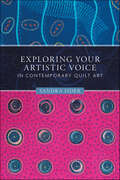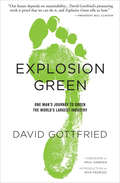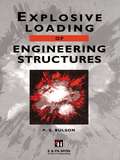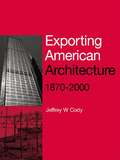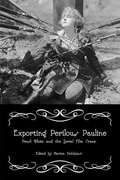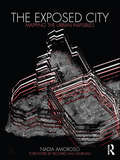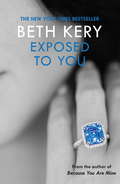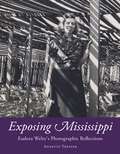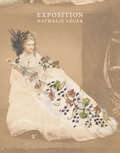- Table View
- List View
Exploring Teachers in Fiction and Film: Saviors, Scapegoats and Schoolmarms
by Melanie ShoffnerThis book about teachers as characters in popular media examines what can be learned from fictional teachers for the purposes of educating real teachers. Its aim is twofold: to examine the constructed figure of the teacher in film, television and text and to apply that examination in the context of teacher education. By exploring the teacher construct, readers are able to consider how popular fiction and film have influenced society’s understandings and views of classroom teachers. Organized around four main themes—Identifying with the Teacher Image; Constructing the Teacher with Content; Imaging the Teacher as Savior; The Teacher Construct as Commentary—the chapters examine the complicated mixture of fact, stereotype and misrepresentation that create the image of the teacher in the public eye today. This examination, in turn, allows teacher educators to use popular culture as curriculum. Using the fictional teacher as a text, preservice—and practicing—teachers can examine positive and negative (and often misleading) representations of teachers in order to develop as teachers themselves.
Exploring the Boundaries of Landscape Architecture
by Simon Bell Ingrid Sarlöv Herlin Richard StilesWhat have cultural anthropologists, historical geographers, landscape ecologists and environmental artists got in common? Along with eight other disciplines, from domains as diverse as planning and design, the arts and humanities as well as the social and natural sciences, they are all fields of importance to the theory and practice of landscape architecture. In the context of the EU funded LE:NOTRE Project, carried out under the auspices of ECLAS, the European Council of Landscape Architecture Schools, international experts from a wide range of related fields were asked to reflect, each from their own perspective, on the interface between their discipline and landscape architecture. The resulting insights presented in this book represent an important contribution to the development the discipline of landscape architecture, as well as suggesting new ways in which future collaboration can help to create a greater interdisciplinary richness at a time when the awareness of the importance of the landscape is growing across a wide range of disciplines. Exploring the Boundaries of Landscape Architecture is the first systematic attempt to explore the territory at the boundaries of landscape architecture. It addresses academics, professionals and students, not just from landscape architecture but also from its neighbouring discipline, all of whom will benefit from a better understanding their areas of shared interest and the chance to develop a common language with which to converse.
Exploring the Concept of Feel for Wellbeing and Performance: How We Lost the Felt Experience, Why it Matters, and How to Return to Our Natural Way of Being
by Jay Kimiecik Doug NewburgThis book analyses and unpacks the term Feel by exploring its many definitions and examples in real life. Incorporating psychological theories and case studies, it offers a groundbreaking look into what it means to Feel and its importance in people’s everyday lives. Experiencing life without Feel has led to many deleterious performance, health, and wellbeing consequences. Exploring the Concept of Feel for Wellbeing and Performance takes a deep dive into the origins and definitions of Feel, asking what has happened to the Feel experience, and what people must do to recoup their Feel. With a highly accessible tone and clear structure, the book provides its readers with effective ways to improve performance and enhance wellbeing. The authors challenge the status quo of both performance science and wellbeing practices and begin a conversation on why people should be more proactive when it comes to their Feel. Anyone interested in helping themselves or others with performance excellence and wellbeing will benefit from this book, which blends science and practice and provides many examples of people from all walks of life who live with Feel. The book will also be key reading for students and practitioners interested in sport psychology, leadership studies, mental health studies counselling, and life coaching.
Exploring the Elements of Design
by Poppy Evans Mark ThomasWith the same straightforward approach and dynamic examples that made the first edition so popular, this fully revised second edition of Exploring The Elements of Design again presents the very latest in graphic design concepts side by side with some of the best contemporary design work. Created by two leading designer-educators as a very practical and very visual introduction to the art of graphic design, this richly illustrated full-color book offers clear explanations of the fundamental principles, award-winning examples of professional work, and diagrams that clearly show how these principles operate in successful design solutions. Coverage begins with primary design elements, moves on to the use of color, typography, and imagery, and concludes with an overview of the field of graphic design and related career options. The revised second edition adds new and insightful material on creative thinking, visual problem-solving, and research strategies used to pursue effective design solutions plus Web and New Media applications to reflect the most current media design trends--all designed to prepare readers for success in every aspect of the ever-changing world of graphic design.
Exploring the Land of Ooo: An Unofficial Overview and Production History of Cartoon Network's Adventure Time
by Paul A. ThomasExploring the Land of Ooo: An Unofficial Overview and Production History of Cartoon Network’s "Adventure Time" is a guide through the colorful and exuberant animated television series that initially aired from 2010 to 2018. Created by visionary artist Pendleton Ward, the series was groundbreaking and is credited by many with heralding in a new golden age of animation. Known for its distinct sense of humor, bold aesthetic choices, and memorable characters, Adventure Time has amassed a fan-following of teenagers and young adults in addition to children. Popularly and critically acclaimed, the show netted three Annie awards, eight Emmys, and a coveted Peabody.In this thorough overview, author Paul A. Thomas explores the nuances of Adventure Time’s characters, production history, ancillary media, and vibrant fandom. Based in part on interviews with dozens of the creative individuals who made the show possible, the volume comprises a captivating mix of oral history and primary source analysis. With fresh insight, the book considers the show’s guest-directed episodes, outlines its most famous songs, and explores how its characters were created and cast. Written for fans and scholars alike, Exploring the Land of Ooo ensures that, when it comes to Adventure Time, the fun truly will never end.
Exploring the Selfie: Historical, Theoretical And Analytical Approaches To Digital Self-photography
by Julia Eckel Jens Ruchatz Sabine WirthThis volume explores the selfie not only as a specific photographic practice that is deeply rooted in digital culture, but also how it is understood in relation to other media of self-portrayal. Unlike the public debate about the dangers of 'selfie-narcissism', this anthology discusses what the practice of taking and sharing selfies can tell us about media culture today: can the selfie be critiqued as an image or rather as a social practice? What are the technological conditions of this form of vernacular photography? By gathering articles from the fields of media studies; art history; cultural studies; visual studies; philosophy; sociology and ethnography, this book provides a media archaeological perspective that highlights the relevance of the selfie as a stereotypical as well as creative practice of dealing with ourselves in relation to technology.
Exploring the Spatiality of the City across Cultural Texts: Narrating Spaces, Reading Urbanity (Geocriticism and Spatial Literary Studies)
by Martin Kindermann Rebekka RohlederExploring the Spatiality of the City across Cultural Texts: Narrating Spaces, Reading Urbanity explores the narrative formations of urbanity from an interdisciplinary perspective. Within the framework of the “spatial turn,” contributors from disciplines ranging from geography and history to literary and media studies theorize narrative constructions of the city and cities, and analyze relevant examples from a variety of discourses, media, and cities. Subdivided into six sections, the book explores the interactions of city and text—as well as other media—and the conflicting narratives that arise in these interactions. Offering case studies that discuss specific aspects of the narrative construction of Berlin and London, the text also considers narratives of urban discontinuity and their theoretical implications. Ultimately, this volume captures the narratological, artistic, material, social, and performative possibilities inherent in spatial representations of the city.
Exploring the Universe: A Practical Guide for Hobbyists (The Patrick Moore Practical Astronomy Series)
by James DireHave you ever wanted to get better at observing the universe but didn't know where to begin? Have you ever wondered what you are looking at in the night sky? Whether you are just beginning or an advanced amateur astronomer, you will want to have this book in your astronomical library. This book wraps up an entire astronomy course around the study of astronomical images, all of which have been taken by the author. The fascinating images contained herein will inspire readers to explore the descriptions of astronomical objects of all types and the physical processes they undergo throughout the universe. The author is both a career astronomy professor and an avid amateur astronomer who owns an arsenal of small telescopes for observing and conducting CCD imaging. The author’s descriptions are at a level any reader can follow. Using his own images, mostly taken with smaller telescopes as opposed to Hubble, James Webb, or multi-meter mountain top observatories, show amateur astronomers and hobbyists what can be accomplished by using modest and affordable equipment. The book begins with a primer on telescopes and the myriad types on the market today. You'll read about why there are so many models as well as the advantages and disadvantages of each. This is followed by an introduction to astrophotography, a complete description of paper and digital start atlases available today, and a discussion on celestial nomenclature – why are celestial objects named what they are named! You'll learn about light, and how it interacts with matter to create what we see in the night sky. Finally, you'll go on a grand tour of the Universe, from the Moon and Sun to comets, nebulae, star clusters and galaxies.
Exploring Theatre (Ntc: Exploring Theatre Ser.)
by Nancy Olive Prince Jeanie JacksonNIMAC-sourced textbook
Exploring Transdisciplinarity in Art and Sciences
by Zoï Kapoula Emmanuelle Volle Julien Renoult Moreno AndreattaThe book is organized around 4 sections. The first deals with the creativity and its neural basis (responsible editor Emmanuelle Volle). The second section concerns the neurophysiology of aesthetics (responsible editor Zoï Kapoula). It covers a large spectrum of different experimental approaches going from architecture, to process of architectural creation and issues of architectural impact on the gesture of the observer. Neurophysiological aspects such as space navigation, gesture, body posture control are involved in the experiments described as well as questions about terminology and valid methodology. The next chapter contains studies on music, mathematics and brain (responsible editor Moreno Andreatta). The final section deals with evolutionary aesthetics (responsible editor Julien Renoult).Chapter "Composing Music from Neuronal Activity: The Spikiss Project" is available open access under a Creative Commons Attribution-NonCommercial 4.0 International License via link.springer.com.
Exploring Visual Design: The Elements and Principles
by Joseph A. Gatto Albert W. Porter Jack SelleckNIMAC-sourced textbook
Exploring Visual Design: The Elements And Principles
by Joseph Gatto Albert Porter Jack SelleckThis beautiful 258 page book is filled with dozens of color and black and white photos and illustrations exploring the elements and principles of design.
Exploring Woodworking
by Fred W. Zimmerman Larry J. McWardExploring Woodworking provides a thorough foundation for a beginning woodworking course. This clearly written and highly illustrated text introduces students to woods and their characteristics, as well as basic woodworking techniques using both hand and power tools. Plans for a number of woodworking products are included.
Exploring Woodworking (Eighth Edition)
by Fred W. Zimmerman Larry J. Mcward Don L. BlazekExploring Woodworking provides the essential knowledge that beginning students require. It introduces different woods and their characteristics in addition to basic techniques using hand and power tools. Information regarding woodworking operations, such as drilling and sawing, is presented in individual chapters to ensure in-depth coverage. Product designs for woodworking projects are included. An entrepreneurship chapter explains how to organize and operate an in-school manufacturing business, giving students hands-on experience with financing, marketing, and construction. The text also introduces students to the industrial woodworking environment to provide insight into the potential workplace.
Exploring Your Artistic Voice in Contemporary Quilt Art
by Sandra SiderThis compact guide will make a huge impact on how you choose to express yourself in quilt art. Think of the artists whose work you admire, individuals with a distinctive style or perhaps several styles developed over the years. You might like their use of color, materials, craft expertise, and subject matter. But above all, you recognize in these makers an authenticity, a confident approach to the quilt medium. That is their artistic voice. Develop your own unique artistic voice, see your work mature, and become confident and happy with what you are doing in the studio. Renowned quilt artist Sandra Sider acts as a companion along the path to discovering your voice, and offers photos of dozens of her own quilt design successes and failures as examples to learn from. Even blind alleys, detours, and the road not taken can lead to developing one’s voice as a quilt artist—indeed, as any sort of creative maker. Topics include how to write a powerful artist's statement for yourself, when to stop experimenting, and using your voice once you own it. Looking to broaden your quilting experience, or simply curious about the concept of an artistic voice? Look no further—this is the perfect guide for you!
Explosion Green: One Man's Journey to Green the World's Largest Industry
by David GottfriedThe inspiring true account of one man&’s successful mission to bring sustainability into the building industry around the world. The winner of three Indie Book Awards, Explosion Green tells the twenty-year story of the global green building movement through the eyes of David Gottfried, the man who helped start it all. Explosion Green reveals the inner workings of the building industry as it comes to grips with the need for environmentally friendly practices. It describes how the industry has evolved, and how this evolution has helped fight climate change and prevent further damage to the environment while creating a multibillion-dollar industry. Filled with his unique insight and self-deprecating humor, Gottfried&’s riveting memoir demonstrates how one person can start a global movement. &“Our future depends on sustainability . . . David Gottfried&’s pioneering work is proof that we can do it, and Explosion Green tells us how.&” —President Bill Clinton &“Transformation of the most important sector in the nation&’s energy economy resulted from David Gottfried&’s pioneering work. Students and professionals will be inspired by this book as it describes the pathway that led to such monumental results.&” —Gil Masters, Professor Emeritus of Civil and Environmental Engineering, Stanford University &“David inspires us to believe we have the ability to envision a future that we might create. He has lived it firsthand and generously shares his learning with us.&” —Maria Atkinson Am, Cofounder, Green Building Council of Australia
Explosive Loading of Engineering Structures
by P.S. BulsonThis book reviews the development of research into the explosive loading of structures, mainly since the beginning of the twentieth century. Major contributions in the fields of measurement, analysis and prediction are discussed. Dynamic loading from conventional high explosives is examined, as well as the effects of liquid propellant, dust, gas, vapour, and fuel/air explosions. Subjects include blast in tunnels, underground and underwater explosions, pressure measurement and blast stimulation. Explosive effects on civil buildings, civil bridges, aircraft and ships are summarized, including the estimation of residual strength. The concluding passages refer to structural safety and reliability.
Expo 67
by Rhona Richman Kenneally Johanne SloanExpo 67, the world's fair held in Montreal during the summer of 1967, brought architecture, art, design, and technology together into a glittering modern package. Heralding the ideal city of the future to its visitors, the Expo site was perceived by critics as a laboratory for urban and architectural design as well as for cultural exchange, intended to enhance global understanding and international cooperation. This collection of essays brings new critical perspectives to Expo 67, an event that left behind a significant material and imaginative legacy.The contributors to this volume reflect a variety of interdisciplinary approaches and address Expo 67 across a broad spectrum ranging from architecture and film to more ephemeral markers such as postcards, menus, pavilion displays, or the uniforms of the hostesses employed on the site. Collectively, the essays explore issues of nationalism, the interplay of tradition and modernity, twentieth-century discourse about urban experience, and the enduring impact of Expo 67's technological experimentation. Expo 67: Not Just a Souvenir is a compelling examination of a world's fair that had a profound impact locally, nationally, and internationally.
Exporting American Architecture 1870-2000 (Planning, History and Environment Series)
by Jeffrey W. CodyThe export of American architecture began in the nineteenth century as a disjointed set of personal adventures and commercial initiatives. It continues today alongside the transfer of other aspects of American life and culture to most regions of the world. Jeffrey Cody explains how, why and where American architects, planners, building contractors and other actors have marketed American architecture overseas. In so doing he provides a historical perspective on the diffusion of American building technologies, architectural standards, construction methods and planning paradigms. Using previously undocumented examples and illustrations, he shows how steel-frame manufacturers shipped their products abroad enabling the erection of American-style skyscrapers worldwide by 1900 and how this phase was followed by similar initiatives by companies manufacturing concrete components.
Exporting Chinese Architecture: History, Issues and “One Belt One Road”
by Charlie Qiuli Xue Guanghui DingThis book studies the unexplored history of China-aided architecture erected in the developing world since the 1950s. By 2019, over 1,000 buildings had been delivered to more than 160 countries, including parliament houses, convention centers, stadiums, gymnasiums, theaters, schools, hospitals, libraries, railways, and stations. These projects, which have played a significant role in promoting economic transformation, cultural engagement and social and environmental well-being, have largely been overlooked or misunderstood by the international community. Why did China donate so many foreign-aid buildings? How were these buildings built in the remote land of developing countries with intricate influences and limited resources? Have they helped modernize the recipient countries? The authors of this book use a wide range of representative projects built in different historic periods and geographical locations as case studies to address the above questions from various perspectives. This book fills an enormous gap in modern architecture in China and the world. It offers architectural students and scholars in various disciplines the necessary knowledge on "diplomatic architecture"; informs architects the appropriate methods of cross-border design and low-tech building; teaches government officials the best practice of donating and receiving foreign-aid buildings; and enhances public awareness of cultural diversity in Asia, Africa, Oceania, and Latin America. With abundant first-hand materials, historical pictures, and drawings, the book is a must-read for those who are interested in modern architecture and developmental aid in the world. China’s architecture abroad, notably in Africa and Asia, has been perceived with both fascination and anxiety. Based on a wealth of sources often difficult to access for scholars from outside China, this book links the history and present of China’s architectural mobilities in ways that will stimulate new debates in architectural history and urban studies. - Łukasz Stanek, Professor of Architectural History, The University of Manchester, UK
Exporting Perilous Pauline: Pearl White and Serial Film Craze
by Marina DahlquistExceptionally popular during their time, the spectacular American action film serials of the 1910s featured exciting stunts, film tricks, and effects set against the background of modern technology, often starring resourceful female heroines who displayed traditionally male qualities such as endurance, strength, and authority. The most renowned of these "serial queens" was Pearl White, whose career as the adventurous character Pauline developed during a transitional phase in the medium's evolving production strategies, distribution and advertising patterns, and fan culture. In this volume, an international group of scholars explores how American serials starring Pearl White and other female stars impacted the emerging cinemas in the United States and abroad. Contributors investigate the serial genre and its narrative patterns, marketing, and cultural reception, and historiographic importance, with essays on Pearl White's life on and off the screen as well as the "serial queen" genre in Western and Eastern Europe, India, and China. Contributors are Weihong Bao, Rudmer Canjels, Marina Dahlquist, Monica Dall'Asta, Kevin B. Johnson, Christina Petersen, and Rosie Thomas.
The Exposed City: Mapping the Urban Invisibles
by Nadia AmorosoThere is a vast amount of information about a city which is invisible to the human eye – crime levels, transportation patterns, cell phone use and air quality to name just a few. If a city was able to be defined by these characteristics, what form would it take? How could it be mapped? Nadia Amoroso tackles these questions by taking statistical urban data and exploring how they could be transformed into innovative new maps. The "unseen" elements of the city are examined in groundbreaking images throughout the book, which are complemented by interviews with Winy Maas and James Corner, comments by Richard Saul Wurman, and sections by the SENSEable City Lab group and Mark Aubin, co-founder of Google Earth.
Exposed To You: One Night of Passion Book 4 (One Night of Passion)
by Beth KeryFrom the New York Times ebook bestselling author of the Because You Are Mine series and The Affair, for fans for Sylvia Day, J. Kenner and Maya Banks. This is the fourth in Beth Kery's One Night of Passion series about a group of connected characters who each begin their romance with a night of impulsive, steamy sex...It's not often you're hired to paint a body tattoo on a total stranger at a Hollywood film set and reserved art teacher Joy will never forget it. Certain she'll never see him again, she gives herself completely in a moment of passionate desire. Little does she know the man is film star Everett Hughes. For Everett, women and sex come as easily as fame. How can he convince the guarded Joy that beneath the hard body and sexy façade of celebrity is a real man who wants only one, real woman? In the heat of an intoxicating affair, Everett endeavours to break down her barriers, gain her trust, and expose himself as the real deal. But can Joy do the same, and reveal to him the vulnerable woman who longs to be loved, wanted, and desired for ever? Lose yourself in One Night of Passion: Addicted To You, Bound To You, Captured By You, Exposed To You, Only For You.
Exposing Mississippi: Eudora Welty's Photographic Reflections (Critical Perspectives on Eudora Welty)
by Annette TrefzerWINNER OF THE 2022 EUDORA WELTY PRIZEInternationally known as a writer, Eudora Welty has as well been spotlighted as a talented photographer. The prevalent idea remains that Welty simply took snapshots before she found her true calling as a renowned fiction writer. But who was Welty as a photographer? What did she see? How and why did she photograph? And what did Welty know about modern photography? In Exposing Mississippi: Eudora Welty's Photographic Reflections, Annette Trefzer elucidates Welty’s photographic vision and answers these questions by exploring her photographic archive and writings on photography. The photographs Welty took in the 1930s and ’40s frame her visual response to the cultural landscapes of the segregated South during the Depression. The photobook One Time, One Place, which was selected, curated, and shaped into a visual narrative by Welty herself, serves as a starting point and guide for the chapters on her spatial hermeneutic. The book is divided into sections by locations and offers how the framing of these areas reveals Welty’s radical commentary of the spaces her camera captured. There are over eighty images in Exposing Mississippi, including some never-before-seen archival photographs, and sections of the book draw on over three hundred more. The chapters on institutional, leisure, and memorial landscapes address how Welty’s photographs contribute to, reflect on, and intervene in customary visual constructions of the Depression-era South.
Exposition
by Nathalie LégerThe first in Nathalie Léger&’s acclaimed genre-defying triptych of books about the struggles and obsessions of women artists. Exposition is the first in a triptych of books by the award-winning writer and archivist Nathalie Léger that includes Suite for Barbara Loden and The White Dress. In each, Léger sets the story of a female artist against the background of her own life and research—an archivist's journey into the self, into the lives that history hides from us. Here, Léger's subject is the Countess of Castiglione (1837–1899), who at the dawn of photography dedicated herself to becoming the most photographed woman in the world, modeling for hundreds of photos, including &“Scherzo di Follia,&” among the most famous in history. Set long before our own &“selfie&” age, Exposition is a remarkably modern investigation into the curses of beauty, fame, vanity, and age, as well as the obsessive drive to control and commodify one's image.
